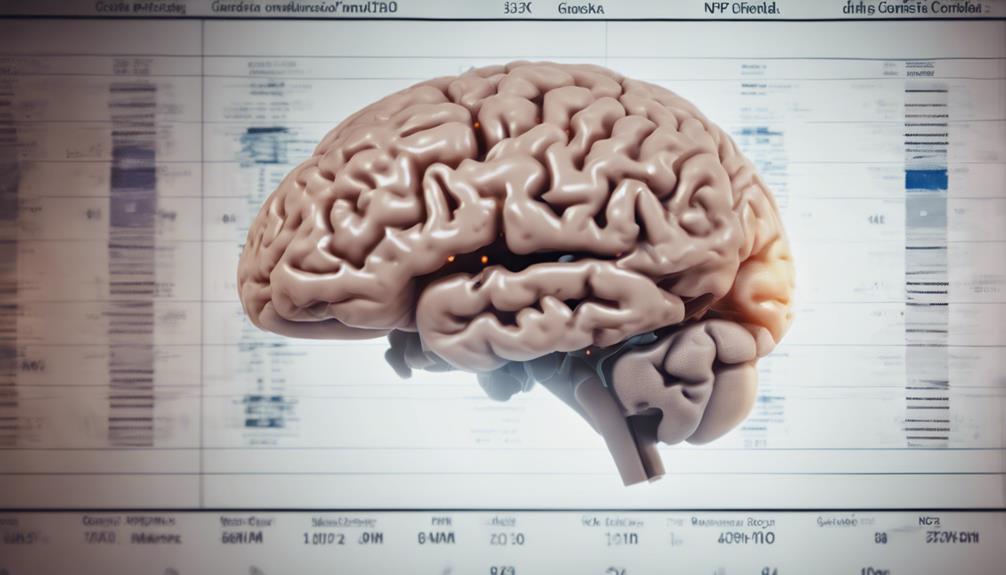The journey of understanding Narcissistic Personality Disorder started with early psychoanalytic theories that distinguished normal from defensive narcissism. Groundbreaking contributions by Sigmund Freud, Otto Rank, and others laid the groundwork for the formal recognition of NPD in 1980. Characteristics such as grandiosity, manipulative tendencies, and fragile self-esteem are key identifiers. The complexities of NPD involve maintaining a positive self-image, entitlement, and a constant need for admiration. Recognizing these patterns is crucial. Genetic predisposition, negative experiences, and environmental influences contribute to NPD. Treatment options like cognitive-behavioral therapy offer hope. Each layer reveals a deeper understanding of this intricate disorder.
Key Takeaways
- Narcissistic Personality Disorder (NPD) was formally recognized in 1980.
- Diagnostic criteria focus on impaired personality functioning.
- The recognition of NPD led to tailored treatment approaches.
- Renowned psychoanalysts like Otto Kernberg explored NPD characteristics.
- Diagnostic criteria refinement enhanced accuracy in NPD assessments.
Early Psychoanalytic Theories and Narcissism
In exploring the origins of Narcissistic Personality Disorder, early psychoanalytic theories from the early 1900s shed light on the differentiation between normal and defensive narcissism. Sigmund Freud, a pioneer in psychoanalysis, distinguished between these forms of narcissism in 1914, linking them to the energy directed towards oneself.
Alongside Freud, Otto Rank and Karl Abraham also contributed greatly to understanding narcissistic characteristics during this period. These early theorists examined the roots of narcissism, emphasizing the impact of early childhood experiences and social relationships on the development of narcissistic traits.
Additionally, Martin Buber's concept of 'I-Thou' versus 'I-It' relationships provides a valuable framework for exploring narcissism. Wilhelm Reich further expanded on these ideas by proposing that defensive body armor acts as a protective mechanism in narcissistic individuals.
Freud's Concept of Narcissism

Freud's conceptualization of narcissism intertwines the notions of libido and self-directed energy within his theory of personality. He described primary narcissism as the redirection of libido inward towards oneself, where individuals focus on self-love and self-gratification. Within Freud's framework, the ego ideal emerges as a result of societal norms and interactions, shaping an individual's aspirations and values.
In Freud's model of personality, the Id represents primal desires, the Ego mediates between the Id and the Superego, which embodies societal standards. Freud proposed that shifting love from oneself to others could help maintain satisfaction and balance within the personality structure. This transfer of affection was seen as essential for healthy psychological development.
Freud's insights into narcissism laid the groundwork for understanding how self-love and external influences shape an individual's sense of self and aspirations. The interplay of libido, primary narcissism, and the ego ideal highlights the complexity of human personality according to Freud's psychoanalytic perspective.
Formal Recognition of NPD

The formal recognition of Narcissistic Personality Disorder (NPD) in 1980 by the psychiatric community was a significant milestone in mental health.
This recognition led to the establishment of diagnostic criteria that focused on identifying individuals with specific impairments in personality functioning, such as grandiosity and lack of empathy.
The impact of this recognition extended to shaping treatment approaches and providing support for individuals struggling with NPD.
Recognition by Psychiatric Community
Upon its formal recognition by the psychiatric community in 1980, Narcissistic Personality Disorder (NPD) gained defined diagnostic criteria, marking a significant advancement in understanding this complex personality disorder. Prior to this recognition, renowned psychoanalysts such as Otto Kernberg and Heinz Kohut had already explored the characteristics and dynamics of NPD.
The acknowledgment of NPD by the psychiatric community was essential in differentiating it from other personality disorders, aiding in precise diagnosis and treatment. This formal recognition represented a milestone in the field of psychiatry, enabling mental health professionals to better grasp the nuances of NPD and develop targeted interventions.
The establishment of diagnostic criteria for NPD further solidified its place within the spectrum of personality disorders, enhancing the accuracy of assessments and therapeutic approaches.
Diagnostic Criteria Established
With the formal recognition of Narcissistic Personality Disorder (NPD) in 1980, clear diagnostic criteria were established, delineating key traits and behaviors characteristic of this complex personality disorder. The Diagnostic and Statistical Manual of Mental Disorders (DSM) outlined criteria that include grandiosity, a pervasive need for admiration, lack of empathy, and impaired personality functioning.
These specific diagnostic criteria enable clinicians to identify and diagnose individuals with NPD based on observable behavioral and psychological patterns. The establishment of these criteria marked a significant milestone in the field of mental health, allowing for a more systematic approach to understanding and categorizing personality disorders.
This formal recognition has also played a critical role in advancing research, treatment, and support for individuals grappling with the challenges of narcissistic personality disorder.
Impact on Treatment
Recognizing Narcissistic Personality Disorder in 1980 sparked a paradigm shift in mental health treatment strategies. The formal recognition of NPD in the DSM allowed for the establishment of specific diagnostic criteria, improving the precision of identification and treatment for individuals with the disorder.
Mental health professionals now have standardized guidelines for evaluating NPD and implementing tailored interventions. This milestone not only increased awareness among professionals and the public but also paved the way for research and advancements in treatment approaches.
Specialized interventions have been developed to address the unique challenges faced by individuals with NPD, offering targeted support and care. The inclusion of NPD in the DSM has had a profound impact on the field of psychology, enhancing the quality of care provided to those with this personality disorder.
Characteristics of NPD Individuals

Individuals with Narcissistic Personality Disorder (NPD) often display traits such as grandiosity, entitlement, and a lack of empathy.
They manipulate relationships for personal gain, seek constant admiration, and struggle with criticism.
Understanding these characteristics can help identify and navigate interactions with NPD individuals effectively.
NPD Traits Overview
Narcissistic Personality Disorder traits encompass grandiosity, a constant need for admiration, and a lack of empathy among individuals affected by this condition. Those with NPD often manipulate others to meet their own desires, showing entitlement and superiority. Criticism and rejection are particularly challenging for narcissists, as they struggle with emotional regulation.
This disorder is linked to a distorted self-image, fragile self-esteem, and emotional insecurity. The prevalence of narcissistic traits varies among different cultures and populations, impacting their relationships and interactions. Understanding these traits is essential for recognizing and dealing with individuals exhibiting such behaviors. By acknowledging these characteristics, one can better navigate interactions with those who've Narcissistic Personality Disorder.
Behavioral Patterns Displayed
The behavioral patterns displayed by individuals with Narcissistic Personality Disorder often reveal a preoccupation with maintaining excessively positive self-concepts. When observing individuals with NPD, one may notice a grandiose sense of self-importance and entitlement. Manipulation is a common tactic they use to control situations and people around them.
Their lack of empathy towards others can manifest in callous or insensitive behavior. Additionally, their self-esteem is fragile, leading them to seek constant admiration and validation from others to reinforce their inflated self-image. Understanding these behavioral patterns is essential in recognizing and dealing with individuals who exhibit traits associated with Narcissistic Personality Disorder.
Complexity of NPD

Understanding the complexity of Narcissistic Personality Disorder involves delving into the intricate interplay of maladaptive behaviors and their impact on daily functioning. Individuals with NPD often struggle with maintaining healthy relationships due to their distorted self-image, constant need for validation, and sense of entitlement. These core features of NPD contribute to interpersonal challenges, making it difficult for individuals to connect with others on a genuine level.
The maladaptive patterns of behavior displayed by those with NPD, such as manipulative tendencies to uphold their grandiose self-image, can further complicate their interactions with others. These behaviors are often driven by an underlying fragility in self-esteem, leading individuals with NPD to seek admiration and validation from external sources.
In essence, the complexity of NPD lies in the intricate web of behaviors, emotions, and thought patterns that shape an individual's experience with this personality disorder. By unraveling these complexities, we can gain a deeper understanding of how NPD manifests and its profound impact on an individual's life.
Etiology of NPD

Exploring the origins of Narcissistic Personality Disorder reveals a complex interplay of genetic predisposition, negative developmental experiences, and environmental factors. Understanding the etiology of NPD can shed light on the factors contributing to its development.
- Genetic predisposition: Genetic factors play a role in the development of NPD, with heritability contributing notably to its manifestation.
- Negative developmental experiences: Childhood trauma, abuse, or neglect can have a profound impact on the development of NPD, highlighting the importance of early experiences in shaping personality.
- Environmental factors: Parenting styles emphasizing excessive praise or lacking appropriate boundaries can contribute to the development of NPD, underscoring the influence of environmental factors on personality disorders.
- Heritability: Recent research supports the influence of genetic factors in personality disorders, including NPD, emphasizing the complex interplay between genetic predisposition and environmental influences.
- Complex interplay: The etiology of NPD involves a multifaceted interaction between genetic predisposition, environmental factors, and early childhood experiences, illustrating the intricate nature of this personality disorder.
Diagnosis of NPD

When diagnosing Narcissistic Personality Disorder (NPD), clinicians rely on specific criteria outlined in the DSM, such as grandiosity and lack of empathy. Additionally, tools like the Narcissistic Personality Inventory (NPI) assist in identifying behaviors associated with NPD.
It's important to take into account the severity and impact of narcissistic traits to distinguish between NPD and a narcissistic personality type.
Criteria for NPD
To diagnose Narcissistic Personality Disorder (NPD), clinicians evaluate specific criteria outlined in the DSM, focusing on traits such as grandiosity, need for admiration, lack of empathy, and impairments in personality functioning. When considering the criteria for NPD, it's crucial to look for:
- Grandiosity
- Need for admiration
- Lack of empathy
- Impairments in personality functioning
- Stability over time
These criteria help clinicians differentiate between NPD and other personality types, ensuring an accurate diagnosis. By carefully examining these traits and impairments, professionals can identify individuals whose behaviors significantly impact their lives, leading to the proper management and treatment of Narcissistic Personality Disorder.
Assessment Tools for NPD
We utilize the Narcissistic Personality Inventory (NPI) as a key tool in evaluating narcissistic behaviors for diagnosing Narcissistic Personality Disorder (NPD). The NPI, a self-report questionnaire, is instrumental in the clinical diagnosis of NPD, with high scores on this assessment often correlating with the presence of narcissistic traits.
This inventory comprises forced-choice items that aim to capture various facets of narcissistic behavior, including arrogance, vanity, and self-centeredness. Clinicians rely on the NPI to assess individuals for these traits, aiding in the identification and evaluation of NPD.
Treatment Options for NPD

Effective treatment for Narcissistic Personality Disorder (NPD) commonly involves cognitive-behavioral therapy (CBT) to address maladaptive behaviors and thought patterns. Apart from CBT, other treatment options can also be beneficial in managing NPD. These include:
- Group Therapy: Providing support, feedback, and opportunities for interpersonal skill development.
- Medication: Prescribed to manage associated symptoms like depression or anxiety.
- Therapeutic Approaches: Focus on addressing underlying emotional issues and improving self-awareness.
- Long-Term Commitment: Treatment often requires a sustained commitment to therapy to promote self-reflection and behavioral changes.
These treatment options aim to help individuals with NPD develop healthier coping mechanisms, improve their relationships, and enhance their overall quality of life. It's essential for individuals with NPD to work closely with mental health professionals to determine the most effective treatment plan tailored to their specific needs and circumstances.
Evolution of NPD Understanding

The historical evolution of Narcissistic Personality Disorder (NPD) understanding traces back to the resurgence of interest in the 1950s, prominently led by Heinz Hartman and ego psychologists. At that time, there was a lack of widely accepted psychotherapeutic methods for NPD.
However, by the 1970s, advancements in understanding and treating the disorder started to emerge. Self psychology and object relations approaches gained prominence in addressing NPD due to their effectiveness, contrasting with Freud's psychoanalytic techniques that were deemed ineffective for narcissistic patients.
This realization prompted the development of new therapeutic strategies tailored specifically for individuals with NPD. The move away from traditional psychoanalytic methods towards more effective approaches marked a significant evolution in the understanding and treatment of NPD.
As researchers explored further into the complexities of narcissistic personality disorder, the field of psychology saw remarkable progress in deciphering the intricacies of this challenging condition.
Research Contributions to NPD

Research into Narcissistic Personality Disorder (NPD) has been greatly influenced by key theorists and their groundbreaking theories throughout the 20th century. These contributions have shaped our understanding and treatment of NPD.
- Otto Rank and Karl Abraham: Early in the 1900s, these pioneers laid the foundation for understanding narcissistic traits.
- Heinz Kohut: In the 1950s, Kohut's self-psychology theory revolutionized how we approach NPD, focusing on the individual's sense of self.
- Otto Kernberg: Kernberg's work in the 1980s integrated Freudian theory with object relations, leading to advancements in diagnosing NPD.
- Modern Theorists: Key figures like Kohut, Kernberg, and Masterson have continued to influence modern perspectives on NPD.
- Diagnostic Criteria: The official recognition and establishment of diagnostic criteria for NPD in 1980 marked a significant step in the evolution of psychoanalytic perspectives on this disorder.
These research contributions have been crucial in enhancing our understanding and management of NPD.
Frequently Asked Questions
What Is the Origin of Narcissistic Personality Disorder?
Narcissistic Personality Disorder originates from a complex interplay of genetic factors, early childhood experiences, and environmental influences. It manifests as a pervasive pattern of grandiosity, a need for admiration, and lack of empathy. These individuals often have fragile self-esteem and are hypersensitive to criticism.
Understanding the origins of this disorder helps in developing effective treatment strategies and interventions to support individuals struggling with these challenging symptoms.
When Was Narcissistic Personality Disorder First Recognized?
Narcissistic Personality Disorder was first officially recognized as a mental illness in 1980. The roots of NPD can be traced back to ancient Greek mythology with the story of Narcissus.
Scientific interest in excessive self-admiration, known as hubris, dates back to the early 1900s. Austrian psychoanalyst Otto Rank provided early descriptions of narcissism in 1911.
The diagnosis and establishment of diagnostic criteria for NPD occurred in 1980.
What Is the Origin of the Npd?
The origin of NPD can be traced back to disturbances in early social relationships and unsatisfactory interactions with caregivers during childhood. These experiences contribute to the development of narcissistic traits and behaviors.
Austrian psychoanalysts, such as Otto Rank and Heinz Kohut, played key roles in shaping our understanding of narcissism.
The concept of NPD as a personality disorder with specific diagnostic criteria emerged in the late 20th century, paving the way for targeted research and treatment approaches.
What Is the Theory Behind Narcissistic Personality Disorder?
The theory behind Narcissistic Personality Disorder involves a complex interplay of genetic predisposition, negative developmental experiences, and fragile ego formation in childhood.
Developmental factors, such as trauma, abuse, and neglect, contribute to the development of NPD.
This disorder falls under Cluster B personality disorders and is associated with difficulties in relationships and a distorted self-image.
Subtypes of NPD, including grandiose and vulnerable types, showcase different manifestations of the disorder.
Conclusion
To sum up, research has shown that narcissistic personality disorder affects approximately 1% of the population, with men being more likely to be diagnosed than women.
Understanding the complexities of NPD and the various treatment options available is essential in providing support and care for individuals with this disorder.
By continuing to study and research NPD, we can improve our knowledge and approach to effectively addressing the needs of those affected by this condition.
Chris brings a wealth of knowledge and personal experience to the role of Expert Author. With a focus on narcissistic personality disorder and recovery processes, Chris’s articles offer a mix of expert analysis, personal anecdotes, and actionable advice. Their work enriches our platform with depth, authenticity, and a perspective that resonates with those who have experienced narcissism firsthand.











